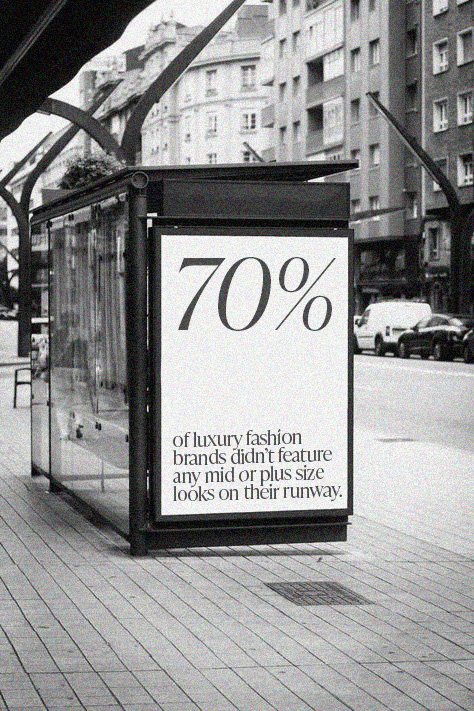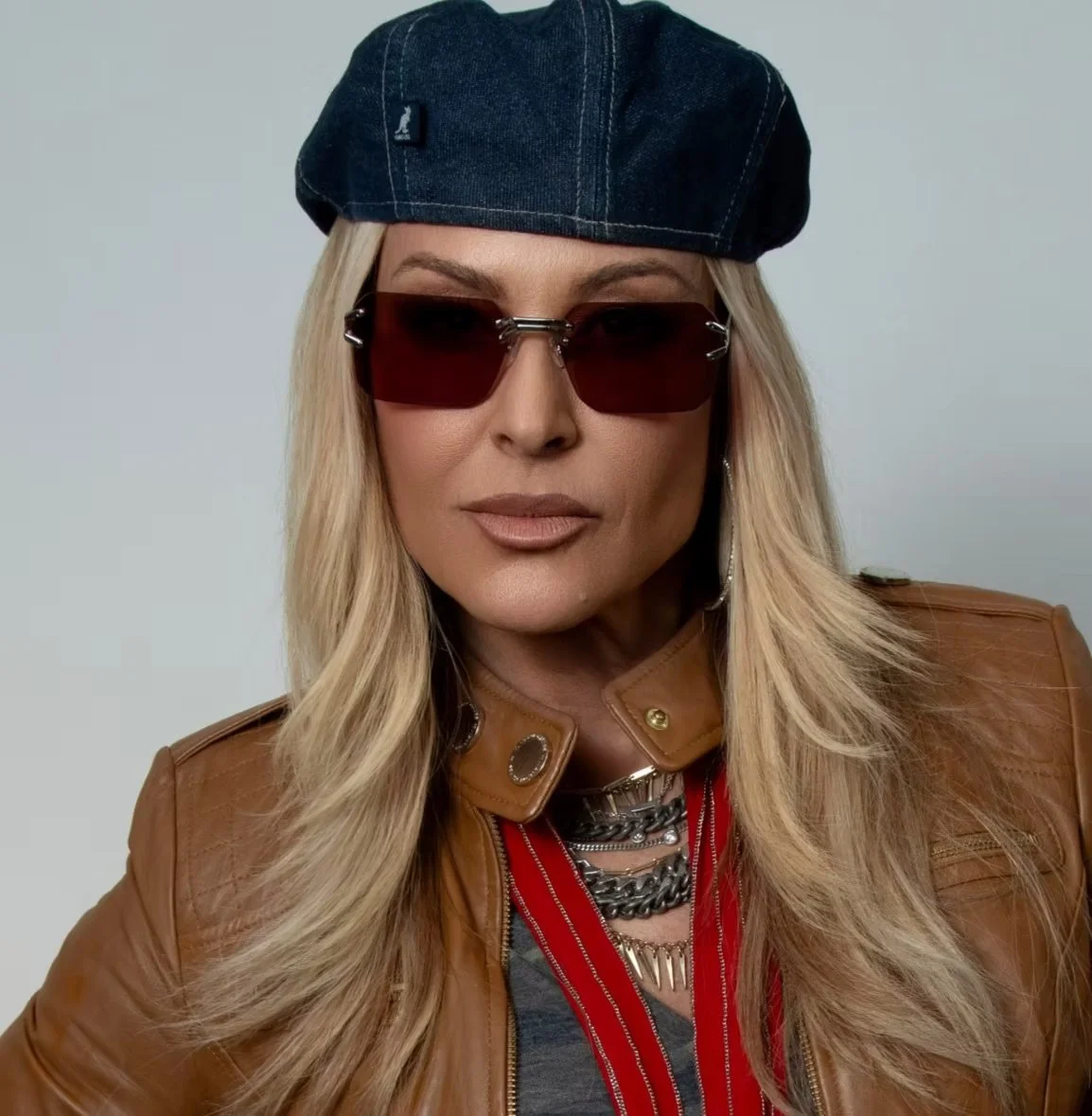Fashion Continues to Not Care About Size Inclusivity
Fashion Continues to Not Care About Size Inclusivity
HURS analyzed the body diversity across the Fall/Winter 2023 runway shows of 50 of the most recognizable womenswear brands in today’s luxury fashion industry. The results were disheartening.
By Bonnie Langedijk
I’ve always had a difficult relationship with my body. The singular slim body type that has been celebrated in fashion magazines and on runways for decades made me dislike it even more. Up until my teens I was always on the heavier side and the pressure of keeping the weight off has been a load I’ve carried with me since. The fashion industry played a big role in this with glossy magazines making me believe that bigger bodies simply weren’t worthy of love or celebration. Working in the fashion industry over the past decade has confirmed this sentiment, with past colleagues and collaborators going to extreme lengths to create environments where skinniness is encouraged and celebrated and where fatphobia is shamelessly expressed.
Today, I look at how Paloma Elsesser, Jill Kortleve and Precious Lee have fought their way onto the covers of the magazines and runways of the most established brands in fashion and I’m proud to witness progress. I’m proud of the 24 magazine covers that featured plus-size models in 2022 and the 103 plus-size appearances on the Fall/Winter 2022 runways, yet I’m reminded that these runway numbers account for a mere 2.34 percent of total castings. With the Fall/Winter 2023 fashion month ending last week it was evident that progress was nowhere to be found.
Out of the 50 brands HURS analyzed, just 15 showed mid or plus-size models on their runway with a staggering 70 percent of brands not featuring any mid or plus-size looks at all. Courtesy of HURS.
Fashion search engine TAGWALK reported a drop of 24 percent in mid and plus size models on the women’s runways. Courtesy of HURS.
A Retreat to Old Ways: By the Numbers
“A lack of body diversity is something I’ve come to expect from luxury designers,” model and product designer Taja Feistner tells HURS. Feistner, who has modeled for luxury brands including Marc Jacobs, Prada and Gucci recently took to Instagram to publicly share the pressures she felt working in the modeling industry and her personal experience with body dysmorphia. “What was off-putting is that it seemed the body diversity we had begun to see has faded in exchange for a toxic return to heroin chic. It showed an unwinding of progress. Body diversity was nothing more than another passing trend,” she continues.
Glamour’s European Fashion Editor Londiwe Ncube agrees. “The comeback of Y2K and 90s fashion has also brought back those outdated attitudes towards models. We often still associate super slim with luxury and until we shift those attitudes, it’s what a lot of people will aspire to. Don’t we know better by now?” she says.
The retreat to old ways brings back memories for Feistner. “When I started modeling almost a decade ago, you only saw ultra-thin white women on the runway. We’re seeing much more skin tones, ethnicities and ages than before but what has almost never varied are the accepted heights and weights,” she says, explaining how after years of public outcry for more diversity has forced casting directors to expand their casting pool. What could have been a paradigm shift in diversity and inclusion in fashion instead became a box ticking exercise with brands hiring single models to represent the entire ethnic background to meet quotas. “The same tokenism has been applied to body diversity. [Yet] for the most part, if you aren’t a size 0/2, you don’t have a place in the fashion industry, no matter how beautiful you are.”
“What was off-putting is that it seemed the BODY DIVERSITY we had begun to see has faded in exchange for a toxic return to heroin chic. It showed an unwinding of progress.”
The lack of body diversity acceptance by industry insiders goes far deeper than a public call for wider representation. Within the industry, it often affects those at the very heart of the debate, the models themselves. “The most frustrating thing, from my personal experience, is knowing that young models, who rely on their agents to guide them, are falling victim to abusive behavior regarding their bodies. Even with a strong support system from friends and family, young models’ lack of experience and desire to succeed can lead them down a dark path of body dysmorphia and eating disorders. It happened to me,” adds Feistner. “As a model, your body and looks are directly tied to your financial security; and in high fashion, whether you book the shows typically determines the amount of editorials and campaigns you can get. Mentally, that makes the show season feel like a ‘make it or break it’ point and puts an incredible amount of pressure on models to lose weight for the runway.”
For this article, HURS analyzed the body diversity across the Fall/Winter 2023 runway shows of 50 of the most recognizable womenswear brands* in today’s luxury fashion industry. Out of the 50 brands analyzed, just 15 showed mid or plus-size models on their runway with a staggering 70 percent of brands not featuring any mid or plus-size looks at all. London-based Alexander McQueen came out on top, showing five mid and plus size looks across its 55 look line-up, while Coach and Chanel both showed three bigger sizes each. For Chanel, this accounted for roughly 4.6 percent of the total 66 look collection while for Coach the average was higher at 7.9 percent across 38 looks.
“It's a PR stunt. [Brands] 'tick' that box but often the looks worn by plus-size models aren't even produced in shops. That's literally just lying straight to the consumer's face,” says Alexandra van Houtte, Founder and CEO of fashion search engine TAGWALK, which reported a drop of 24 percent in mid and plus size models on the women’s runways. Out of all brands who showed during New York, London, Milan and Paris Fashion Week only 68 brands included at least one model from either category, a decline from 90 brands the season prior. The worst offender this season was Milan Fashion Week where only 13.5 percent of brands casted mid or plus-size models, compared to 25 percent in Paris, 37 percent in New York and 39 percent in London.
The Neglected Plus-Size Market
Not only does the lack of size diversity come at a cost for consumers, but brands refusing to put in the work and showcase a wider assortment of sizes are missing out on big business. According to Statista, the plus-size apparel market value reached $178 billion in 2019, and is projected to surpass $250 billion by 2027.
“There are people of all sizes who want to wear, or at least be inspired by, what they see on the runway. [Excluding these] groups doesn’t send a good message,” says Art Director and Style Curator Alexis Foreman. “There are so many brands who create pieces that would translate easily to even the slightest of size increase but who aren’t doing it. The Row for instance — they could so easily cast larger models who would fit the sample size.”
Claudia Wagner, Co-Founder and Head of Growth at Ubooker, a premium model and talent booking platform, has experienced the industry both as a model and now from the agency side. She knows growing sizing offerings impacts businesses in more ways than one. “There’s still a long way to go, particularly where it comes to the runway. But to be fair, it comes with timing and production issues. Collections have tight timelines and sample sizes are always ready at the last minute. Sample sizes have historically been small because clothing patterns have always been small and then graded up and corrected during production. So to show a collection in all the different sizes is really not an easy task.”
Still, independent brands are quicker to embrace size diversity on their runways, in ad campaigns and across their product offering in store compared to their heritage luxury counterparts, seeing both a monetary and ethical point in diversifying their offering. “They’re innovative in their casting, from age to size to genders. They have no rules, everyone is welcome. That should be the spirit,” says van Houtte. Taja Feistner agrees, adding a point of caution, “Unless you’re aware of the younger independent brands in fashion who [embrace] body diversity, you won’t see the representation of your body on the runway.”
Raden Prasetya for Usplash
“It Has to Become a Rule, Not a Choice”
So where does that leave us when a few casting directors, brands and editors continue to hold the power? What can we do to move the narrative forward?
“Size diversity is vital. The majority of the population is a size UK 16/EU 44/US 14 and above. All models who walk down the [runway] are a size UK 6-8/EU 34-36/US 4-6. It's a complete misrepresentation of how clothes fall and look,” TAGWALK’s Alexandra van Houtte says. “It has to become a rule, not a choice. If you impose a quota where brands have to include a minimum of 8 percent of their total models in a size 10 or above, it makes it fair for everyone.”
Houtte’s suggestion isn’t new, yet it could be an effective way to hold brands and publications accountable. Copenhagen Fashion Week, for instance, already sets sustainability standards which brands need to comply with to be allowed on the city’s fashion show schedule. Taking a similar approach to sizing is bound to work. “I’ve been in spaces that have resisted moving towards size inclusivity out of fear but once they do, the response is always positive. Women deserve to see more representation of bodies in the industry, it’s as simple as that,” says Londiwe Ncube of Glamour.
Feistner suggests a shorter term solution. “Support brands that are inclusive and boycott the ones that aren’t. CEOs and brand owners focus on the bottom line, so if a brand is losing money, the creatives at the top typically get replaced. Keep the conversations going, be loud, and demand change. The more we talk and share our vulnerabilities and concerns, the more we realize we’re not alone in the way we feel. It’s that connectedness that ultimately drives change.”
*For this article, HURS analyzed the world’s most prominent 50 luxury brands and their most recent Fall/Winter 2023 runways, and reviewed their size diversity. Brands analyzed included: Acne Studios, Alexander Mcqueen, Balenciaga, Balmain, Bottega Veneta, Burberry, Chanel, Chloé, Coach, Coperni, Diesel, Dior, Dolce & Gabbana, Dries van Noten, Etro, Fendi, Ferragamo, Giorgio Armani, Givenchy, Gucci, Hermès, Isabel Marant, Jil Sander, JW Anderson, Khaite, Loewe, Louis Vuitton, Marc Jacobs, Max Mara, Michael Kors, Missoni, Miu Miu, Moschino, Off-White, Paco Rabanne, Prada, Proenza Schouler, Rick Owens, Sacai, Saint Laurent, Schiaparelli, Stella McCartney, The Row, Thom Browne, Tod’s, Tory Burch, Valentino, Versace, Victoria Beckham and Vivienne Westwood.







